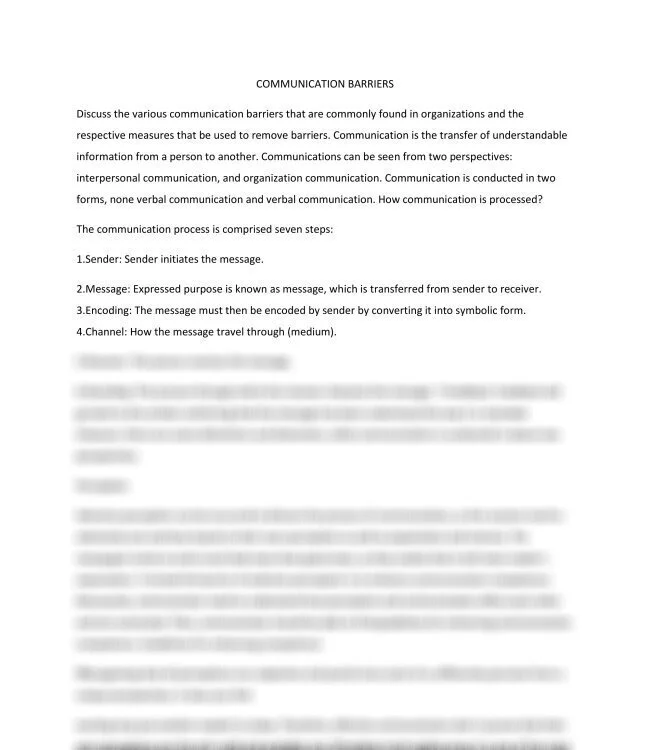COMMUNICATION BARRIERS Discuss the various communication barriers that are commonly found in organizations and the respective measures that be used to remove barriers. Communication is the transfer of
COMMUNICATION BARRIERS Discuss the various communication barriers that are commonly found in organizations and the respective measures that be used to remove barriers. Communication is the transfer of
(intentional). (medium). (unintentional). 1.Sender: 2.Message: 3.Encoding: 4.Channel: 5.Receiver: 6.Decoding: 7.Feedback: A Age, All Although American Arab Arab-Israeli As Australian BARRIERS Basically, Being Big Britain Communication Communications Conflict Culture Discuss Electronic Emotion Emotional Employees English, English. Ethnocentrism Example, Expressed Feedback Filtering For Gender Guidelines How However, Indian Information Israel It Language Less Let Likely, Men Moreover, National Necessarily, Obviously, Parts People Perception Physical Represents Selective Sender Singaporean Singlish, Some Still, The Then, There Therefore, This To Understanding We When Which Women Words a ability able above access accuracy activities. addresses advance affect after agreement agreement. all allowance almost alone also always among an and angry another another. are as as: assume attain available avoided avoided. back background bad barrier barrier: barriers barriers. based basically be because become been behaviors. beliefs, beneficial best between bias: big borderless. boundaries break busy but by by: calm calm, calm. can caused causes certain chain chance check clarify class clear collective come commitment common commonly communicate communicated communicating communicating, communication communication, communication. communications communicator communicators communicators. communities. company competence competence. comprised conducted confirm confirming conflict conflict. conflict: connected. connection connotation considered conversation conversation. converting create cultural culture culture: cultures cultures. customer data. decrease definition delay detail difference different differently disposition. disregard distance distance. distortions distract distraction, distraction: distractions distraught, diversity do do. doesn’t dominant don’t down. dysfunction each easier easily educated educated, education, ee effective effective, effectively. efforts either electronic eliminated. email emotion emotional emotional, emphasize employees encoded encounter encouraged enhance enhancing entertainments. ethnocentric ethnocentrism excessive exciting executives expectation expectation. expects, experience express expression expression, face face, facing factors faster. favorably fear feel feeling filtering. filtering: find first five for form. formal forms, found four friend, from generation get give given giving global go goal gone good gradual group groups, guidelines hand happen happy harm has have he heads heads, hear help helping helps high his how ideas, if ignore important important, impose in includes incoming ineffective. inefficiently influence information information, initiates insight instance, intended. intentionally interest. interests. interference. intermediate interpersonal interpret interpreted interpreting into involving is issue it its judge judgments judgments. just knocked know known lack language language, languages. later, lead leads length less level life. likely listening, long low mails make makes man manager manager. manipulates many markets may mean meaning meaning. measures meet members men message message, message. messages mind minimize minimized mistake misunderstand misunderstanding misunderstandings more most mostly much must mutually my nations nations, need needs negatively neighbors. news news, newspaper next no nod none norms, not number objective obvious occurred occurs of office.” office?” older omitted on one one. one’s only open operated opposing or order? orders. organization organization. organizations organizations. other others others, others. other’s our ourselves. out overload own partial participating particular parties parts, party’s pass passed people people. people’s perceive perception perceptions person perspectives, perspectives. perspectives: physical please practices prefer primary problem problem, problem. process processed? properly. provided provides purpose purpose. pushes put quickly. range rational rationed. reach reaction read, reader’s reading reality realize receiver receiver. receivers, receiver’s receives reduced. refer relationships. remove removed. resentment resource respective responses responsible revolutionized right rule-regulated sale say say, scalar screen see seen selective selectively self-sacrifice sender seven shaking should sides significant similar simple since sites. situation six skill skills, sleep. smoothly so social solutions solve some sort speak speaks spend stand standard standing statement, statements status stay staying steps: straight structures, student style. subjective subordinates substitute such sustains symbolic synthesize system takes talk talk. techniques technology technology, telecommunications tells tend tends term than that the their them then there these they things thinking this those thrCOMMUNICATION three through time time, time. to today’s together. tone totally touring transfer transferred travel truth try two types. understand understandable understands understood unfavorably unhappy. unintentionally unique until us use used valid values, variety various verbal very wants way we well what when which while who will willing with withdrawal without women won’t word words words. work world would write wrong. you younger “Could “come Accommodation: Advance Avoidance: Avoiding Be Being Certain Checking Collaboration: Competition: Compromise: Difficult Experiencing How Jargons Openness Recognizing Reducing Resisting Sender Time Tone Word Working Sender
COMMUNICATION BARRIERS
Discuss the various communication barriers that are commonly found in organizations and the respective measures that be used to remove barriers. Communication is the transfer of understandable information from a person to another. Communications can be seen from two perspectives: interpersonal communication, and organization communication. Communication is conducted in two forms, none verbal communication and verbal communication. How communication is processed?
The communication process is comprised seven steps:
1.Sender: Sender initiates the message.
2.Message: Expressed purpose is known as message, which is transferred from sender to receiver. 3.Encoding: The message must then be encoded by sender by converting it into symbolic form. 4.Channel: How the message travel through (medium).
5.Receiver: The person receives the message.
6.Decoding: The process through which the receiver interpret the message. 7.Feedback: Feedback will go back to the sender confirming that the message has been understood the way it is intended. However, there are some distortions and distraction, while communication is conducted in above two perspectives.
